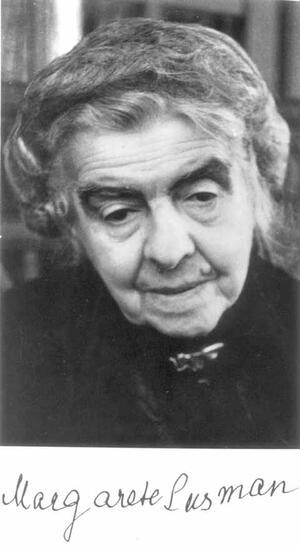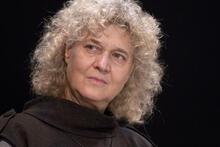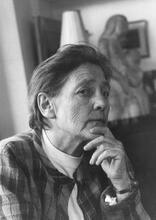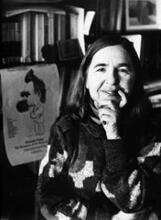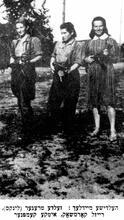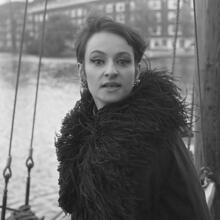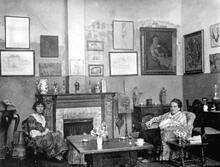Margarete Susman
Born in Hamburg in 1872, Margarete Susman studied art in school and soon entered Berlin’s vibrant social scene. Sensing the threat of antisemitism to German Jews early, she moved in Switzerland in 1933. She had published her first writings, a book of poetry, in 1901 and went on to have a prolific writing career that included plays, books, essays, and journal articles. Susman combined literature and theory, often reflecting on the work of Nietzsche and Freud and other seminal texts of modern theory and addressing political issues and women’s rights. Her writings concentrate on the most problematic issues of the modern world: God and human beings, man and woman, Jew and Christian. Susman continued writing until her death in 1966.
Writing Career and Themes
Poems, a drama, essays, newspaper and journal articles, books, letters, an autobiography—the writings of Margarete Susman are as heterogeneous as her interests. Her work often spanned the boundary between literature and theory. In addition to five collections of poems, she published a book-length essay on contemporary poetry (1910), one of the first attempts to come to terms with modernist poems that were poised on the abyss of silence. She wrote respected essays on Franz Kafka, Jean Paul (1762–1825) and Adalbert Stifter (1805–1868) and published a book on the women of Romanticism, among them Dorothea Schlegel and Rahel Levin Varnhagen. But to classify her as a literary critic would not do her justice. Many of her book reviews address seminal texts of modern theory: Georg Lukacs’s Die Seele und die Formen (The Soul and the Forms), Ernst Bloch’s Geist der Utopie (Spirit of Utopia), and Franz Rosenzweig’s Der Stern der Erlösung (Star of Redemption).
For Susman, any consideration of modernity must start with Nietzsche and Freud, two thinkers to whom she returned again and again. Her reflections concentrate on the most problematic issues of the modern world: God and human beings, man and woman, Jew and Christian. The outbreak of World War I revealed to her what she called “the guilt of our unpolitical life,” and her response was to integrate politics into her thinking. Her essays on Gustav Landauer (1870–1919) and Rosa Luxemburg, both murdered in 1919, take up the immediate question of how to engage the revolutionary movements shaking Germany after the war.
When, after Germany’s defeat in 1918, women gained the vote as well as the right to become university professors, her reaction was more complex than mere celebration. While programmatic writings in the context of the women’s movement give the impression that women had simply been excluded from important areas of an otherwise intact world, Margarete Susman suspected that the capitulation of these patriarchal institutions to women’s aspirations might itself be a symptom of the crisis in the masculine world to which the war also bore witness. In “Transformations of Woman,” an essay of 1933 looking back at the revolution of 1918, Susman writes: “The women’s movement at its start was unproblematic and naïve. It emerged from the firm ground of a world whose hidden fragility it failed to sense. In striving for an equal status before the laws of men, the right to work under his orders and on his projects, and the free introduction of her own into the masculine world, her struggle appeared at first as a competition with man for his world. But when almost overnight the doors to this longed-for world were opened, it entered into the most catastrophic collapse. It became clear: Man, no longer had a world to offer woman; all his orders and laws had disintegrated.” From this “homelessness and vital anxiety of man” grew a dangerous longing for the “protective mystical Universal Mother: the magna Mater.” But woman, as bereft of metaphysical support in the modern world as man was, could not fulfill this longing. “The contemporary, new, autonomous, self-confident woman with great dreams in her heart, who can hardly be entirely expunged from even the most modest, laborious female existence, no longer has a partner in this world. She is thrown onto her own resources, immeasurably isolated.” Man and woman no longer confront one another as “question and counterquestion”; since the heavens emptied, their dialogue, carried out for the most part as struggle, now lacks a metaphysical anchor. “Upon awakening from a dream as long as European history, woman stands freezing in the emptiness.”
Early Life
Margarete Susman very early sensed the threat antisemitism posed to Germany and German Jews. She left her homeland in the spring of 1933 and never returned. Switzerland, her new home, was not a foreign country to her. Her father, Adolph Susman (1836–1892), a successful businessman, and her mother, Jenni (née Katzenstein, 1845–1906), had moved to Zürich in 1885, when she was eleven years old.
Margarete Susman was born in Hamburg on October 14, 1872. After studying art for several years in Düsseldorf and Paris—her father forbade her to study at Zürich’s university—she resided in Munich, where she met her best woman friend, Gertrud Kantorowicz (1876–1945), who later perished in Theresienstadt. In 1905 she married the painter Eduard von Bendemann (1877–?) but refused to convert to Protestantism. The couple lived first in Berlin, where their son Erwin was born in 1906. There, Susman frequented the “jours” or regular social gatherings in the house of Gertrud (1864–1938) and Georg Simmel (1858–1918) and formed close friendships with Martin Buber and Bernhard Groethuysen (1880–1946). World War I found her in Switzerland. Afterwards, she lived in a small village in southern Germany and in Frankfurt am Main. Margarete Susman divorced her husband in 1928.
With the rise of Nazism in Germany, Switzerland itself had changed for her. Since she was living in the German-speaking part of the country, she was confronted with a new experience. German, her native tongue, the language in which she thought and wrote, had turned into an unavoidable enemy: “One can barely conceive of the horror: the language I myself spoke had become terror to me.”
Later Life
After years of deep depression—Gertrud Kantorowicz and Susman’s sister Paula (1871?–1942) had attempted to escape to Switzerland via Austria and been caught at the border, where Paula committed suicide—Susman turned to the book of Job to try to understand what had happened to Jews all over Europe. In 1945 she published Das Buch Hiob, the first book on the Shoah, a Lit. (Aramaic) "holy." Doxology, mostly in Aramaic, recited at the close of sections of the prayer service. The mourner's Kaddish is recited at prescribed times by one who has lost an immediate family member. The prayer traditionally requires the presence of ten adult males.Kaddish for her murdered people. Turning again to Rosa Luxemburg’s letters, she found a sentence that helped her to work through her “bitter rage” over what had happened: “Such is life, and so must we accept it—bravely, unafraid, and smiling—in spite of all that.”
In spite of all that, she then proceeded to write a book on the difficult love affair between Wolfgang von Goethe and Charlotte von Stein. In Susman’s account, this oft-told story becomes a metaphor for the ruined relationship between Jews and Germans. At the end of her life, she would write: “The culture in which I was raised lies behind me like a distant and minuscule island.”
Almost totally blind, Margarete Susman died in Zürich on January 16, 1966, shortly after completing her memoirs, entitled Ich habe viele leben gelebt (I have lived many lives).
Selected Works by Margarete Susman
Books and Edited Works:
Mein Land. Gedichte. Berlin/Leipzig: 1901.
Erwin Kircher. Philosophie der Romantik. ed. Heinrich Simon and M. S. Jena: 1906; Neue Gedichte. München/Leipzig: 1907.
Das Wesen der modernen deutschen Lyrik. Stuttgart: 1910.
Vom Sinn der Liebe. Jena: 1912.
Die Liebenden. Drei dramatische Gedichte. Leipzig: 1917.
Lieder von Tod und Erlösung. Gedichte. München: 1922.
Das Kruzifix, Freiburg 1922.
Die Frauen der Romantik. Jena: 1929.
Köln: third edition, 1960, fourth edition, edited by Barbara Hahn, Frankfurt am Main: 1995.
Bertha Pappenheim. Gebete. Edited by the Jüdischer Frauenbund with an afterword by M. S., Berlin: 1936.
Das Buch Hiob und das Schicksal des jüdischen Volkes. Zürich: 1946, second edition 1948, 1968, fourth edition edited and with an afterword by Hermann Levin Goldschmidt 1996.
Deutung einer großen Liebe. Goethe und Charlotte von Stein. Zürich/Stuttgart: 1951.
Aus sich wandelnder Zeit. Gedichte. Zürich: 1953.
Gestalten und Kreise. Aufsätze. Stuttgart/Konstanz: 1954.
Deutung biblischer Gestalten. Zürich: 1956.
Die geistige Gestalt Georg Simmels. Tübingen: 1959.
Vom Geheimnis der Freiheit. Aufsätze. Darmstadt 1964, 1994.
Ich habe viele Leben gelebt. Erinnerungen. Stuttgart: 1964.
Vom Nah- und Fernsein des Fremden. Essays und Briefe. Edited and with an introduction by Ingeborg Nordmann, Frankfurt A. M.: 1992.
Gesammelte Schriften. 5 vol. Edited by Anke Gilleir and Barbara Hahn. Göttingen: Wallstein 2022.
Essays and Reviews:
“Judentum und Kultur.” Frankfurter Zeitung (quoted as FZ), 16.5.1907.
“Neue Lyrik.” FZ, 5.12.1907; 6.3.1908; 4.8.1908; 16.2.1909; 14.7.1909. 17.12.1909.
“Stefan George.” FZ, 6.9.1910.
“Der esoterische Charakter in der heutigen Kunst.” FZ, 31.1.1912.
“Das Kruzifix. Eine Erzählung.” Basler Nachrichten, 6.8.1912.
“Die Seele und die Formen.” FZ, 5.9.1912.
“Zum Verstädnis Nietzsches.” FZ, 7.12.1912.
“Sylvestergespräche.” FZ, 31.12.1912.
“Jean Paul—Zu seinem 150. Geburtstag.” FZ, 21.3.1913.
“Spinoza und das jüdische Weltgefühl.” Vom Judentum. Hans Kohn (ed.), Leipzig: 1913, 51–70.
“Von der Verwirklichung.” FZ, 28.5.1914.
“Das Problem der Tat und das Hamletproblem.” Die Tat, fourth edition (1914), 476–489.
“Der Krieg und das Wort Gottes.” Neue Zürcher Zeitung (im folgenden NZZ), 16.8.1914.
“Vom Krieg und von Gott.” Zeitecho. Ein Kriegstagebuch der Künstler. Berlin: 1915, 164.
“Vom Tun und Erleiden des Krieges.” FZ, 5.4.1915.
“Einzelmoral und Staatsmoral.” FZ, 17.11.1915.
“Wege des Zionismus.” FZ, 17. and 19.9.1916.
“Friedrich Gundolfs Goethe.” FZ, 21.1.1917.
“Davids Tod.” Der Jude 2 (1917), 406–409.
“Vom Tod und von Gott.” Das Buch der Gottesfreunde. Gotha: 1917, 156–163.
“Von Spinozas Leben.” FZ, 29.7.1917.
“Grundfragen der Ästhetik.” NZZ, 13.10.1917.
“Fritz von Unruhs dramatisches Gedicht ‘Ein Geschlecht.’” NZZ, 25.10.1917.
“Vor der Entscheidung.” FZ, 27.2.1918.
“Rahels geistiges Wesen.” Neue Jüdische Monatsschrift 2 (1918), 464–477; “Expressionismus.” FZ, 9.8.1918.
“Schopenhauers Erkenntnislehre.” FZ, 13.9.1918.
“Aufblick.” FZ, 15.11.1918.
“Die Revolution und die Frau.” Das Flugblatt 4, Frankfurt A. M.: 1918.
“Weihnachten.” FZ, 25.12.1918.
“Geist der Utopie.” FZ, 12.1.1919.
“Gott.” FZ, 6.2.1919.
“Gustav Landauer.” Das Tribunal 1 (1919), 72–73.
“Moritz von Egidy.” Friedenswarte. Blätter für zwischenstaatliche Organisation 11 (1919), 150–152.
“Gustav Landauer.” Masken 18 (1919), 150–152.
“Die Revolution und die Juden.” Das Forum 3 (1919), 921–948.
“Lied von Tod und Erlösung.” Das Forum 3 (1919), 803–808.
“Kriegsbriefe deutscher Studenten.” NZZ, 6. and 13.3.1921.
“Der Exodus aus der Philosophie.” FZ, 17.6.1921.
“Die Theorie des Romans.” FZ, 16.8.1921.
“Gestaltwandel der Götter.” NZZ, 21.10.1921.
“Osten und Westen.” FZ, 24.4.1921.
“Der Stern der Erlösung.” Der Jude 6 (1922), 259–264.
“Lasalles Nachlaß.” FZ, 29.1.1922.
“Leo Baecks Wesen des Judentums.” FZ, 2.6.1922.
“An der Grenze.” FZ, 24.12.1922.
“Rosa Luxemburgs Briefe.” Der Aufstieg, 19.1.1923.
“Der Briefwechsel Lasalle-Marx.” FZ, 21.6.1923.
“Pole jüdischen Wesens.” Die Tat 15 (1923), 385–389.
“Der große Maggid.” Die Neue Rundschau 34 (1923), 763–765.
“Europa und Gandhi.” Schweizer Frauenblatt, 15.9.1923.
“Die Brücke.” Der Jude. Sonderheft 1 (1925): 76–84.
“Das Problem der Unsterblichkeit bei Jean Paul.” Jean-Paul-Jahrbuch 1 (1925): 55–77.
“Der Pfarrer ohne Gott.” FZ, 22.8.1925.
“Pontigny 1925.” FZ, 21.9.1925.
“Ernst Bergs ‘Wohin treibt Juda?’.” FZ, 12.2.1926.
“Was kann uns die Bibel heute noch bedeuten?”. Der Morgen 2 (1926), 299–310.
“Pontigny 1926.” FZ, 24.9.1926.
“Das Frauenproblem in der gegenwärtigen Welt.” Der Morgen 2 (1926), 431–452.
“Die Schrift und Luther.” ibid., 528–529.
“Die Weltanschauung Dostojewskis.” ibid., 617–618.
“Martin Buber.” FZ, 8.2.1928.
“Alfred Seidels ‘Bewußtsein als Verhängnis’.” Der Morgen 3 (1927), 338–341.
“Gespräch über Psychoanalyse.” Ibid., 342–343.
“Der romantische Versuch.” Die Kreatur 2 (1927/28).
“Die Botschaft der chassidischen Mystik an unsere Zeit.” Der Jude, Sonderheft 5 (1928): 140–147.
“Die neue Übersetzung der Heiligen Schrift.” Basler Nachrichten, 18.2.1928.
“Rahel.” Der Morgen 4 (1928): 118–138.
“Der Bürger in Frankreich.” FZ, 2.9.1928.
“Auflösung und Werden in unserer Zeit.” Der Morgen 4 (1928): 335–353.
“Das Hiob-Problem bei Franz Kafka.” Der Morgen 5 (1929): 31–49.
“Gustav Landauers Briefe.” ibid., 194–198.
“Die messianische Idee als Friedensidee.” ibid., 375–385.
“Franz Rosenzweig.” FZ, 22.12.1929.
“Die Idee der Ehe und der Ehescheidung.” FZ, 12.1.1930.
“In memoriam Franz Rosenzweig.” In Gedenkbuch für Franz Rosenzweig. Frankfurt: 1930, 8–27.
“Franz Rosenzweig.” Der Morgen 5 (1930): 541–561.
“Saul und David. Zwei ewige Gestalten.” Der Morgen 6 (1930), 171–195.
“Antwort auf einen ‘Offenen Brief an die Deutschen’.” ibid., 300–302.
“Der Bürger in Frankreich.” FZ, 16.11.1930.
“Das Leiden am Ich.” Der Morgen 6 (1930): 493–496.
“Frau und Geist.” Die literarische Welt 7 (1931): 12: 1–2.
“Stern der Erlösung.” Der Morgen 7 (1931): 379–380.
“Zeenah U-Reenah.” ibid., 454–456.
“Kreuz und Davidstern.” FZ, 20.11.1932.
“George Sand.” FZ, 30.12.1932.
“Wandlungen der Frau.” Die neue Rundschau 44 (1933): 105–124.
“Die Schwester.” Goethekalender 1933: 47–61.
“Rahel Varnhagen und Ense. Zu ihrem 100. Todestag.” Die literarische Welt 9 (1933): 10: 7–8, 11/12: 11–12.
“Trost.” Der Morgen 10 (1934): 253–258.
“Karl Wolfskehl. Die Stimme spricht.” ibid., 471–473.
“Stifters Abdias.” Der Morgen 11 (1935): 27–37.
“Vom Chaos unserer Zeit und seiner Überwindung.” Neue Wege. Blätter für den Kampf der Zeit 29 (1935): 5–22.
“Vom geistigen Anteil der Juden im deutschen Raum.” Der Morgen 11 (1935): 107–116.
“Franz Rosenzweigs Briefe.” Blätter des jüdischen Frauenbundes 11 (1935): 2–7.
“Hiob und unserer Zeit.” Neue Wege 30 (1936): 336–350.
“Die Friedensbotschaft des Alten Testaments.” Neue Wege 31 (1937): 246–260.
“Das Reich und die Nachfolge.” Neue Wege 32 (1938): 315.
“Die geistigen Tragkräfte des modernen Kollektivismus.” Neue Wege 33 (1939): 305–442.
“Ezechiel. Der Prophet der Umkehr.” Neue Wege 36 (1942): 8–23.
“Die Botschaft, Reich Gottes.” Ibid., 15–21.
“Friedrich Nietzsche von heute aus gesehen.” Neue Wege 37 (1943): 62–74 and 114–126.
“Der Chassidismus.” Ibid., 310–330.
“Die Gleichnisse Jesu.” Neue Wege 38 (1944): 151–156.
“Die Bergpredigt.” Neue Wege 39 (1945): 155–160.
“Ein Bild.” Neue Wege 40 (1946): 12–17.
“Moses Mendelssohn und seine Entscheidung.” Ibid., 339–364.
“Der Sinn des Anarchismus.” Neue Wege 41 (1947): 5–10, 67–73, and 110-120.
“Das Buch über die Propheten.” Neue Wege 42 (1948): 575–578.
“Leo Tolstoi.” Neue Wege 43 (1949): 104–120.
“Entscheidung.” Ibid. 487–490.
“Das Bibelwerk von Leonhard Ragaz.” Neue Wege 44 (1950): 293–302.
“Ansprache in Weesen.” Neue Wege 45 (1951): 45–52.
“Gerechtigkeit.” Ibid., 281–289.
“Rosa Luxemburg.” Ibid. 435–440.
“Otto Weininger.” NZZ, 9.1.1954.
“Erinnerungen an Georg Simmel.” Buch des Dankes an Georg Simmel. Berlin: 1958, 278–291.
“Georg Simmel. Zum hundertsten Geburtstag.” NZZ, 28.2.1958.
“Es darf keine Verlorenen geben.” Neue Wege 53 (1959): 37–42.
Czajka-Cunico, Anna. "Margarete Susman und ihr poetisch-metaphysisches Werk" Vom Sinn der Liebe"(1912)" (Margarete Susman and her peotic-metaphysical work “From the meaning of love” (1912)). Colloquia Germanica Stetinensia, vol. 29, pp. 27-41. 2020.
Egyptien, Jürgen. Margarete Susman und der George-Kreis. Persönliche Beziehungen, Dichtungstheorie und Weiblichkeitsentwurf (Margarete Susman and the George Circle. Personal relationships, poetry theory and femininity design). Göttingen: Wallstein, 2010.
Gilleir, Anke, and Barbara Hahn, eds. Grenzgänge zwischen Dichtung, Philosophie und Kulturkritik: über Margarete Susman (Boundaries between poetry, philosophy and cultural criticism: on Margarete Susman). Wallstein Verlag, 2012.
Hahn, Barbara. Die Jüdin Pallas Athene. Auch eine Theorie der Moderne. Berlin: 2002.
Hillman, Susanne. "A Few Human Beings Walking Hand in Hand": Margarete Susman, Leonhard Ragaz, and the Origins of the Jewish-Christian Dialogue in Zurich. " The Leo Baeck Institute Yearbook 59, no.1 (2014): 141-162.
Hillman, Susanne. "“A Germ So Tiny”: Margarete Susman's Messianism of Small Steps." Soundings: An Interdisciplinary Journal 96, no. 1 (2013): 40-84.
Lozzi Giuliano. Margarete Susman ei saggi sul femminile (Margarete Susman and the essays on the feminine). Vol. 29. Firenze University Press, 2016.
Rubin, Abraham. "The “German-Jewish Dialogue” and its Literary Refractions: The Case of Margarete Susman and Gershom Scholem." Modern Judaism-A Journal of Jewish Ideas and Experience 35, no. 1 (2015): 1-17.
Schlösser, Manfred (ed.). Für Margarete Susman. Auf gespaltenem Pfad. Darmstadt: 1964.
Steer, Martina. “Da zeigte sich, der Mann hatte ihr keine Welt mehr anzubieten.” Margarete Susman und die Frage der Frauenemanzipation. Bochum: 2001.
Ueckert, Charlotte. Margarete Susman und Else Lasker-Schüler. Hamburg: 2000.

